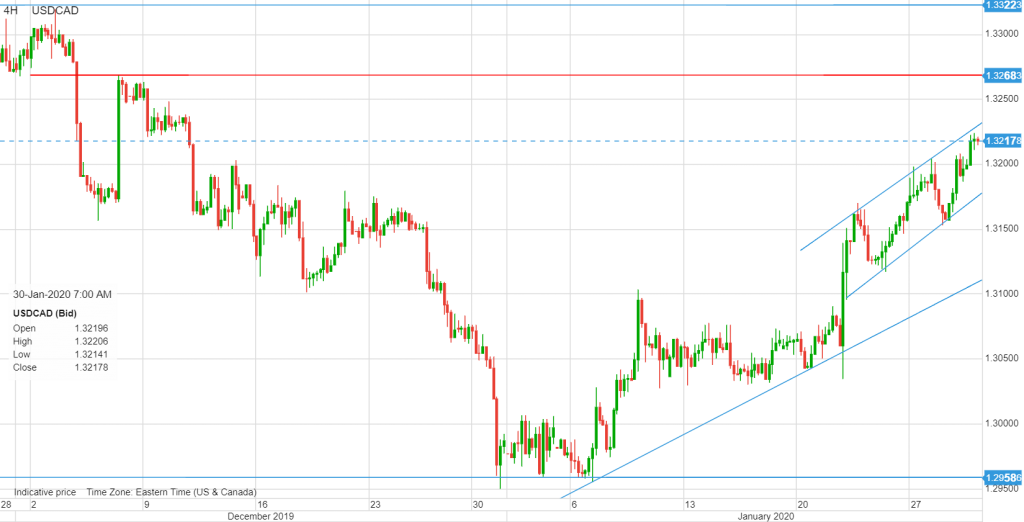
Photo: Needpix.com
January 30, 2020
USDCAD open (6:00 am EST) 1.3218-22 Overnight Range 1.3196-1.3222
The Bank of England surprised traders (at least half of them) and left interest rates unchanged. Two dissenters voted for an immediate cut. The BoE also trimmed 202 GDP growth forecasts to 0.8% from 1.2%. GBPUSD soared on the news, rising from 1.3020 to 1.3107.
US Q4 GDP rose 2.1% q/q, as expected, which is the slowest pace of growth since 2016.
Yesterday afternoon’s FOMC results were the focus in Asia. They left interest rates and policy unchanged, surprising no one. That meant traders could keep their focus on the ever-worsening coronavirus outbreak. China reported the number of coronavirus cases rose to7,711 from 5,074 between Jan.29 and Jan 30, a 29% increase. The number of death rose to 170 from 132 in the same period. India and the Philippines confirmed their first cases of the virus. Russia closed its borders and the World Health Organisation is meeting today to decide if the outbreak should be considered a global emergency.
Asian and European equity markets are down as are oil prices while bond prices and gold are trading higher. US equity futures are pointing to another down day on Wall Street.
The US dollar closed in New York yesterday with small losses against the G-10 majors except against the Canadian dollar, which was joined by AUD and NZD at this mornings open.
Chart: Currency gain/loss (%) against the US dollar from NY close to NY open

Source: Saxo Bank/ IFXA Ltd
EURUSD inched higher after touching 1.1008 overnight, supported by mixed-to-better German and Eurozone economic data, and by the somewhat dovish FOMC statement yesterday. The FOMC tweaked its inflation outlook, from being near its 2.0% objective in December to a hope it would return to the 2.0% objective. EURUSD intraday technicals are modestly bullish above 1.1005 in the context of a longer-term downtrend while prices are below 1.1070.
GBPUSD chopped about in a 1.2979-1.3024 range ahead of the Bank of England policy announcement and then spiked to 1.3107 afterwards. Outgoing BoE Governor Mark Carney said in his press conference that indicators of economic uncertainty have fallen and that they were watching the coronavirus closely.
USDJPY suffered from another bout of coronavirus-fueled risk aversion, which was exacerbated by a drop in 10-year US Treasury yields from 1.637% to 1.569% in early New York trading.
NZDUSD’s rally after a robust trade report was brief, in part because the data was for December and did not account for the risk to its China exports from the coronavirus. AUDUSD tracked Kiwi price action with sinking iron ore prices adding to its woes.
Oil prices continued to be pressured by fears the coronavirus will reduce China’s demand for crude. Making things worse was the EIA report showing US crude inventories rose by 3.5 million barrels in the week ending January 24.
USDCAD rallied on the back of weak oil prices and despite a slightly dovish Fed outlook. The Fed’s view of the US economy contrasts that of the BoC’s view for Canada. The Fed said US economic fundamentals were solid, while the BoC warned indicators of the Canadian economy were mixed, which is another factor supporting prices.
USDCAD Technical Outlook
The USDCAD technicals are bullish and mostly unchanged from yesterday. The uptrend channel, post-Jan. 22 BoC meeting is intact between 1.3170 and 1.3230. Also, the uptrend channel from the beginning of the month is in place above 1.3105. A break above 1.3230 suggests further gains to 1.3290, and then 1.3310. A decisive break of 1.3110 will negate the uptrend. For today, USDCAD support is at 1.3170and 1.3140. Resistance is at 1.3230 and 1.3290. Today’s Range 1.3170-1.3230
Chart: USDCAD 4 hour

Source: Saxo Bank





